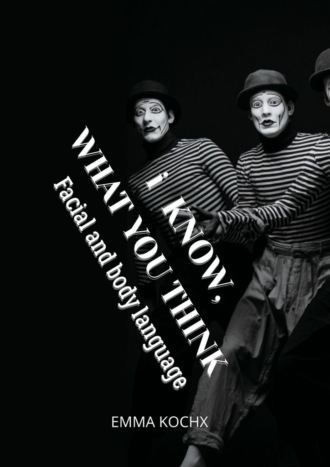
Полная версия
I know, what you think. Facial and body language
3.4. Psychology of Form: Lips, Jaw and the Energy of the Lower Face
A person’s face is not simply a collection of features. It is a living landscape of the soul, and its lower part – lips, jaw, chin – plays a special role in this ensemble. If the eyes are the entrance, then lips and jaw are the exit. Here energy turns into action, word into deed, intention into will. It is precisely here you can read emotional patterns, the level of inner tension and the structure of a person’s psycho-energy.
The jaw is the foundation of the lower face. In physiognomy it symbolizes will, decisiveness, resistance to external and internal pressure. But most importantly – it is the place where emotional and muscular tension accumulates and manifests. Tense jaw. Clenched, as if “locked,” with a pronounced angle and frequent contractions of the chewing muscles – this is an indicator of self-control, suppressed anger, fear of losing control. Such a person usually holds everything inside. They don’t allow themselves “outbursts,” prefer to carry the situation in their “teeth,” yet inwardly are often worn-out. Common among perfectionists, highly responsible people, those with difficult childhoods. Practically: such people often show bruxism (teeth grinding), temporomandibular joint problems, tension headaches.
Relaxed jaw. The line is soft, the mouth freely closed, without lip compression or cheek tension. This signals that a person possesses flexibility in decision-making, emotional fluidity, and a low level of suppressed anger. Such people cope more easily with change, know how to release control. However, if relaxation borders on sluggishness – this is already psycho-energetic exhaustion or low tone.

Psycho-energy of the Lower Face: Strength, Clenching, Leakage
When we look at someone’s face, most often our gaze is drawn to the eyes – to where the soul pulses, where thoughts flash, feelings fade or ignite. But if you move down a bit – to the lips, jaw, chin – you can see something deeper. There is not the play of emotions, but their trace. Not intentions, but internal decision. There lives will. Or its absence.
The lower part of the face is the foundation on which the entire building of personality rests. It is here that readiness to act, to defend boundaries, to assert one’s drive or, on the contrary, to retreat, to contract, to fade into shadow is reflected. It is a kind of psycho-energetic platform that shows how a person manages their powers: whether they hold them inside, expend them without reserve, accumulate them, or waste them.
In people with strong psycho-energy in the lower face, the jawline is clear, but not aggressive. It does not shout for attention, but is present, like the internal framework of character. The chin is steady, balanced, without excessive massiveness or sharpness. The lips are not too tightly pressed, not limp – they are alive, yet held together. Such a person, as a rule, does not lose themselves under pressure. They know what “inner support” means. They need no push – they are already in motion. They may be silent or talkative, but behind every word or gesture there is weight: this is someone who is used to finishing what they start, not scattering themselves over trivialities.
A different picture – faces with suppressed psycho-energy. The jaw seems locked, lips tightly closed, trembling or pressed against the teeth, as if the person holds inside not just words but impulses, feelings, anger. These are faces of fighters, those who have defended too long. They live on the border of tension, and even at rest their muscles continue to serve as defense. Such a face can be handsome, manly, expressive – but there is little peace. Here energy does not flow – it accumulates, like water behind a dam, and either erupts in bursts of irritation, or transforms into internal fatigue. Such people often live with a sense that “everything must be done through effort.” Their will is not soft, but clenched. They are strong – but tired from strength.
A very different impression is given by faces with energy leakage. Here the lower part seems to “drift”: the chin loses clarity, the lips relax, the jaw softens or droops slightly. The gaze may be lively, the face may smile, but still you sense: there is no support inside. Energy does not stay, does not condense into intention, does not turn into decision. These are often the faces of those who are tired not of fighting, but simply of being. Maybe they have gone through a hard period, or from the start lacked habit of inner discipline. They may be kind, creative, sensitive – but weakly grounded. They dream, but don’t act. They feel, but don’t direct. They find it difficult to say “no” – not from weakness, but because there is no cohesion in the lower part of the “energetic body.” Their jaw is like a sapling root: there is potential, but no grounding in the earth.
Psycho-energy of the lower face is not so much about form as about inner tone, about the deep “yes” or “no” to the world. It is the silence in which you can hear – is a person collected or scattered, tense or mobilized, living within themselves or fleeing from themselves. You can learn to see this – not with your eyes, but with attention. Not to judge, but to understand. For the form of the face may change: with time, with pain, with love. But its “psycho-energetic trace” is a reflection of what we do with ourselves each day. And herein lies our choice. Not only anatomical, but spiritual. The lower face is the energetic equivalent of one’s actions and boundaries of personality. Here lives what we are ready to put into the world. It is a kind of accumulator of will, determination, motivation.
How to work with the lower part of the face: 3 practical approaches
Mindfulness.
Pause by the mirror. Observe how you hold your mouth and jaw when you are with no one else. Tension is a signal. And it can be released.
Face fitness and self-massage.
Relaxation of the chewing muscles, work with the orbicularis oris muscle of the mouth – removes suppressed emotions, improves speech, even influences self-esteem.
Emotional hygiene.
Every day reserve 5 minutes for an “emotional exhale” – express what you have been holding back. Write it, say it out loud, draw it, scream – but free the lower part of the face from locked-in words.
The lower face is our emotional foundation and vector of action. By it you can discern who lives inside: a free person or a controller, a warrior or a weary protector, a creator or a critic.
Lips – the language of feeling.
Jaw – the language of will.
And together – our inner voice, reflected in anatomy.
Learning to hear this voice means starting to understand not only others, but ourselves, at a depth accessible only to attentive gaze.
A brief summary. It must be emphasized that the mouth, lips and jaw are not just anatomical forms, but living projections of character, will, and emotional strategy. Lips reveal habitual ways of feeling and expressing emotions, the mouth – the boundary between inner and outer world, and the jaw – the internal lever of action, tension or resistance. Together they form the energetic signature of personality – how a person holds themselves, expresses desire, defends boundaries, and copes with pressure.
Chapter 4. Nose, Ears, Eyebrows – Secondary Signals
When we look at a person, our attention instinctively clings to the eyes and mouth – to what moves, shines, reacts vividly. These are the so-called primary signal zones of the face. They are read first, and often, the first impression is based on them. But against this “loud” background, it’s easy to miss the details – those very secondary signals that are, in fact, the subtle architecture of character. They don’t speak loudly, directly, or bluntly – but they speak honestly, precisely, and deeply. If you learn to hear them, they will reveal more than any words ever could. The nose, ears, and eyebrows – may seem like the periphery. But it is often the periphery that gives away the essence. These are elements that are not easily changed: they are less subject to mimicry, less involved in the social mask, and remain in place even when the rest of the face is pretending. In them is encrypted a person’s structure, their response type, tendencies, hidden beliefs – and even how they perceive the world and themselves.
The Nose – is the vector of the “Self”
It is the vertical, the axis. The nose tells us how a person holds themselves: how they express their desires, how confident they are in their right to be, to take, to demand, to protect.
An angular nose may indicate assertiveness, a willful character, a drive for control.
A soft nose – empathy, flexibility, and a tendency toward compromise.
An overly small or retracted nose may suggest issues with self-assertion, low self-esteem, or a passive life stance.
The Ears – are the attitude toward the world
They are like radars: listening, receiving, filtering. The auricle, its shape, how close it lies to the head or sticks out, the size of the lobes – all of this speaks to the way a person perceives their environment, their level of adaptability, discipline, emotional background, and even attitude toward authority. In physiognomy, ears are often viewed as markers of past experience and ancestral legacy: they show whether a person follows familiar patterns or forges their own path.
The Eyebrows – are boundaries
They are like gates, a frame through which we meet the gaze of another. Eyebrows are a zone of self-protection, reaction, judgment. Their line, density, shape, and angle are key to understanding how a person controls emotions, how observant, hot-tempered, rational, or intuitive they are. From the eyebrows, one can read reaction speed, level of self-control, strength of character, and the tendency toward conflict or reconciliation. In this chapter, we will uncover the art of seeing secondary yet revealing details. We’ll explore how the nose can be a marker of will, the ears – an indicator of inner discipline, and the eyebrows – a chronicle of emotional choices. And most importantly, we will learn to piece these elements together into a single mosaic of personality – to read not only expressions, but also the tuning of the soul; not only mimicry, but the structure of the inner world. Because sometimes, the most important thing is not what shouts – but what quietly exists.
Конец ознакомительного фрагмента.
Текст предоставлен ООО «Литрес».
Прочитайте эту книгу целиком, купив полную легальную версию на Литрес.
Безопасно оплатить книгу можно банковской картой Visa, MasterCard, Maestro, со счета мобильного телефона, с платежного терминала, в салоне МТС или Связной, через PayPal, WebMoney, Яндекс.Деньги, QIWI Кошелек, бонусными картами или другим удобным Вам способом.

